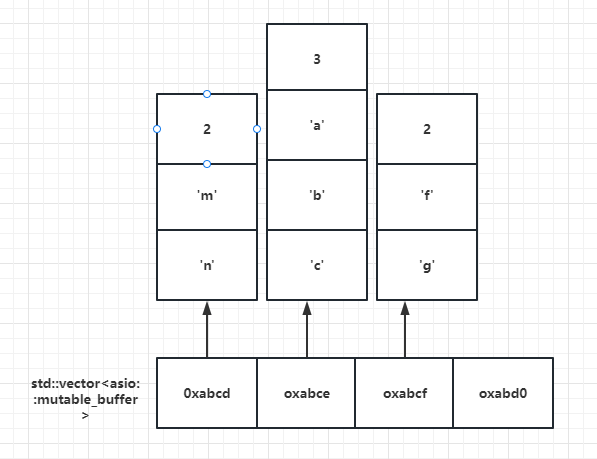网络编程基本流程
网络编程的基本流程对于服务端是这样的
服务端
1)socket——创建socket对象。
2)bind——绑定本机ip+port。
3)listen——监听来电,若在监听到来电,则建立起连接。
4)accept——再创建一个socket对象给其收发消息。原因是现实中服务端都是面对多个客户端,那么为了区分各个客户端,则每个客户端都需再分配一个socket对象进行收发消息。
5)read、write——就是收发消息了。
对于客户端是这样的
客户端
1)socket——创建socket对象。
2)connect——根据服务端ip+port,发起连接请求。
3)write、read——建立连接后,就可发收消息了。
图示如下
相关的网络编程技术可以看看我之前写的文章
https://llfc.club/category?catid=2LUTCbqG3H8TjiCTLIa2BcKIbHp#!aid/2LUgc9QwOBI43XPtWVYw0SznR4N
接下来按照上述流程,我们用boost::asio逐步介绍。
终端节点的创建
所谓终端节点就是用来通信的端对端的节点,可以通过ip地址和端口构造,其的节点可以连接这个终端节点做通信.
如果我们是客户端,我们可以通过对端的ip和端口构造一个endpoint,用这个endpoint和其通信。
int client_end_point() {// Step 1. Assume that the client application has already// obtained the IP-address and the protocol port number.std::string raw_ip_address = "127.0.0.1";unsigned short port_num = 3333;// Used to store information about error that happens// while parsing the raw IP-address.boost::system::error_code ec;// Step 2. Using IP protocol version independent address// representation.asio::ip::address ip_address =asio::ip::address::from_string(raw_ip_address, ec);if (ec.value() != 0) {// Provided IP address is invalid. Breaking execution.std::cout<< "Failed to parse the IP address. Error code = "<< ec.value() << ". Message: " << ec.message();return ec.value();}// Step 3.asio::ip::tcp::endpoint ep(ip_address, port_num);// Step 4. The endpoint is ready and can be used to specify a// particular server in the network the client wants to// communicate with.return 0;}
如果是服务端,则只需根据本地地址绑定就可以生成endpoint
int server_end_point(){// Step 1. Here we assume that the server application has//already obtained the protocol port number.unsigned short port_num = 3333;// Step 2. Create special object of asio::ip::address class// that specifies all IP-addresses available on the host. Note// that here we assume that server works over IPv6 protocol.asio::ip::address ip_address = asio::ip::address_v6::any();// Step 3.asio::ip::tcp::endpoint ep(ip_address, port_num);// Step 4. The endpoint is created and can be used to// specify the IP addresses and a port number on which// the server application wants to listen for incoming// connections.return 0;}
创建socket
创建socket分为4步,创建上下文iocontext,选择协议,生成socket,打开socket。
int create_tcp_socket() {// Step 1. An instance of 'io_service' class is required by// socket constructor.asio::io_context ios;// Step 2. Creating an object of 'tcp' class representing// a TCP protocol with IPv4 as underlying protocol.asio::ip::tcp protocol = asio::ip::tcp::v4();// Step 3. Instantiating an active TCP socket object.asio::ip::tcp::socket sock(ios);// Used to store information about error that happens// while opening the socket.boost::system::error_code ec;// Step 4. Opening the socket.sock.open(protocol, ec);if (ec.value() != 0) {// Failed to open the socket.std::cout<< "Failed to open the socket! Error code = "<< ec.value() << ". Message: " << ec.message();return ec.value();}return 0;}
上述socket只是通信的socket,如果是服务端,我们还需要生成一个acceptor的socket,用来接收新的连接。
int create_acceptor_socket() {// Step 1. An instance of 'io_service' class is required by// socket constructor.asio::io_context ios;// Step 2. Creating an object of 'tcp' class representing// a TCP protocol with IPv6 as underlying protocol.asio::ip::tcp protocol = asio::ip::tcp::v6();// Step 3. Instantiating an acceptor socket object.asio::ip::tcp::acceptor acceptor(ios);// Used to store information about error that happens// while opening the acceptor socket.boost::system::error_code ec;// Step 4. Opening the acceptor socket.acceptor.open(protocol, ec);if (ec.value() != 0) {// Failed to open the socket.std::cout<< "Failed to open the acceptor socket!"<< "Error code = "<< ec.value() << ". Message: " << ec.message();return ec.value();}return 0;}
绑定acceptor
对于acceptor类型的socket,服务器要将其绑定到指定的断点,所有连接这个端点的连接都可以被接收到。
int bind_acceptor_socket() {// Step 1. Here we assume that the server application has// already obtained the protocol port number.unsigned short port_num = 3333;// Step 2. Creating an endpoint.asio::ip::tcp::endpoint ep(asio::ip::address_v4::any(),port_num);// Used by 'acceptor' class constructor.asio::io_context ios;// Step 3. Creating and opening an acceptor socket.asio::ip::tcp::acceptor acceptor(ios, ep.protocol());boost::system::error_code ec;// Step 4. Binding the acceptor socket.acceptor.bind(ep, ec);// Handling errors if any.if (ec.value() != 0) {// Failed to bind the acceptor socket. Breaking// execution.std::cout << "Failed to bind the acceptor socket."<< "Error code = " << ec.value() << ". Message: "<< ec.message();return ec.value();}return 0;}
连接指定的端点
作为客户端可以连接服务器指定的端点进行连接
int connect_to_end() {// Step 1. Assume that the client application has already// obtained the IP address and protocol port number of the// target server.std::string raw_ip_address = "127.0.0.1";unsigned short port_num = 3333;try {// Step 2. Creating an endpoint designating// a target server application.asio::ip::tcp::endpointep(asio::ip::address::from_string(raw_ip_address),port_num);asio::io_context ios;// Step 3. Creating and opening a socket.asio::ip::tcp::socket sock(ios, ep.protocol());// Step 4. Connecting a socket.sock.connect(ep);// At this point socket 'sock' is connected to// the server application and can be used// to send data to or receive data from it.}// Overloads of asio::ip::address::from_string() and// asio::ip::tcp::socket::connect() used here throw// exceptions in case of error condition.catch (system::system_error& e) {std::cout << "Error occured! Error code = " << e.code()<< ". Message: " << e.what();return e.code().value();}}
服务器接收连接
当有客户端连接时,服务器需要接收连接
int accept_new_connection(){// The size of the queue containing the pending connection// requests.const int BACKLOG_SIZE = 30;// Step 1. Here we assume that the server application has// already obtained the protocol port number.unsigned short port_num = 3333;// Step 2. Creating a server endpoint.asio::ip::tcp::endpoint ep(asio::ip::address_v4::any(),port_num);asio::io_context ios;try {// Step 3. Instantiating and opening an acceptor socket.asio::ip::tcp::acceptor acceptor(ios, ep.protocol());// Step 4. Binding the acceptor socket to the// server endpint.acceptor.bind(ep);// Step 5. Starting to listen for incoming connection// requests.acceptor.listen(BACKLOG_SIZE);// Step 6. Creating an active socket.asio::ip::tcp::socket sock(ios);// Step 7. Processing the next connection request and// connecting the active socket to the client.acceptor.accept(sock);// At this point 'sock' socket is connected to//the client application and can be used to send data to// or receive data from it.}catch (system::system_error& e) {std::cout << "Error occured! Error code = " << e.code()<< ". Message: " << e.what();return e.code().value();}}
关于buffer
任何网络库都有提供buffer的数据结构,所谓buffer就是接收和发送数据时缓存数据的结构。
boost::asio提供了asio::mutable_buffer 和 asio::const_buffer这两个结构,他们是一段连续的空间,首字节存储了后续数据的长度。
asio::mutable_buffer用于写服务,asio::const_buffer用于读服务。但是这两个结构都没有被asio的api直接使用。
对于api的buffer参数,asio提出了MutableBufferSequence和ConstBufferSequence概念,他们是由多个asio::mutable_buffer和asio::const_buffer组成的。也就是说boost::asio为了节省空间,将一部分连续的空间组合起来,作为参数交给api使用。
我们可以理解为MutableBufferSequence的数据结构为std::vector<asio::mutable_buffer>
结构如下
每隔vector存储的都是mutable_buffer的地址,每个mutable_buffer的第一个字节表示数据的长度,后面跟着数据内容。
这么复杂的结构交给用户使用并不合适,所以asio提出了buffer()函数,该函数接收多种形式的字节流,该函数返回asio::mutable_buffers_1 o或者asio::const_buffers_1结构的对象。
如果传递给buffer()的参数是一个只读类型,则函数返回asio::const_buffers_1 类型对象。
如果传递给buffer()的参数是一个可写类型,则返回asio::mutable_buffers_1 类型对象。
asio::const_buffers_1和asio::mutable_buffers_1是asio::mutable_buffer和asio::const_buffer的适配器,提供了符合MutableBufferSequence和ConstBufferSequence概念的接口,所以他们可以作为boost::asio的api函数的参数使用。
简单概括一下,我们可以用buffer()函数生成我们要用的缓存存储数据。
比如boost的发送接口send要求的参数为ConstBufferSequence类型
template<typename ConstBufferSequence>std::size_t send(const ConstBufferSequence & buffers);
我们需要将”Hello Word转化为该类型”
void use_const_buffer() {std::string buf = "hello world!";asio::const_buffer asio_buf(buf.c_str(), buf.length());std::vector<asio::const_buffer> buffers_sequence;buffers_sequence.push_back(asio_buf);}
最终buffers_sequence就是可以传递给发送接口send的类型。但是这太复杂了,可以直接用buffer函数转化为send需要的参数类型
void use_buffer_str() {asio::const_buffers_1 output_buf = asio::buffer("hello world");}
output_buf可以直接传递给该send接口。我们也可以将数组转化为send接受的类型
void use_buffer_array(){const size_t BUF_SIZE_BYTES = 20;std::unique_ptr<char[] > buf(new char[BUF_SIZE_BYTES]);auto input_buf = asio::buffer(static_cast<void*>(buf.get()), BUF_SIZE_BYTES);}
对于流式操作,我们可以用streambuf,将输入输出流和streambuf绑定,可以实现流式输入和输出。
void use_stream_buffer() {asio::streambuf buf;std::ostream output(&buf);// Writing the message to the stream-based buffer.output << "Message1\nMessage2";// Now we want to read all data from a streambuf// until '\n' delimiter.// Instantiate an input stream which uses our// stream buffer.std::istream input(&buf);// We'll read data into this string.std::string message1;std::getline(input, message1);// Now message1 string contains 'Message1'.}


发现一些错别字 :每隔vector存储 是不是是每个.
asio::mutable_buffers_1 o或者 是不是多打了个o
io_context 和 io_service 是什么关系 ?
连接修复了,更新为这个专题可以看看, https://llfc.club/category?catid=2LUTCbqG3H8TjiCTLIa2BcKIbHp#!aid/2LXFoFCGTrZnCQ5DAzGTbj9bHNQ
https://llfc.club/articlepage?id=2LXIKWJtKGblnWtHT7TplLKK6ze
这个链接没了
链接好像挂掉了。